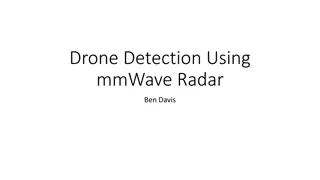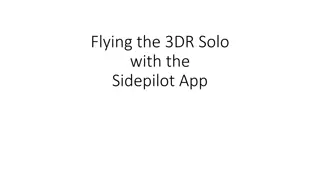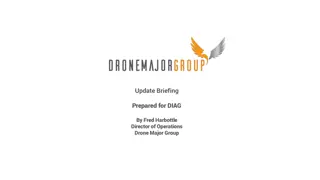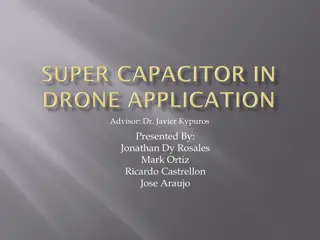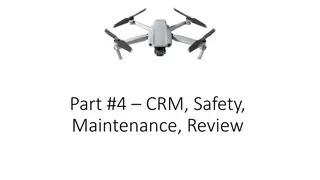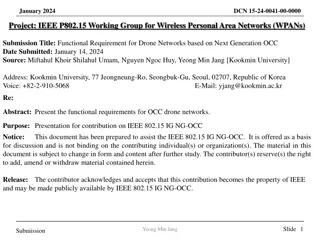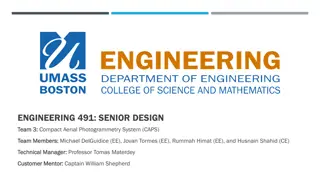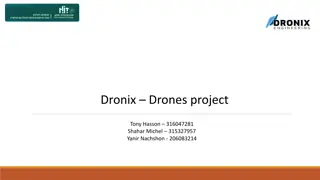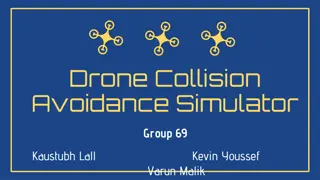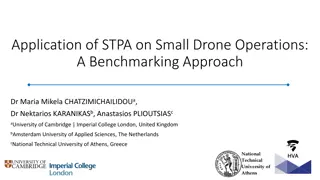
Future Trends in Drone Networks: MAC Protocols for NG OWC
Explore the future direction of MAC protocols for NG OWC in 3D drone networks, focusing on current research trends, multi-objective optimization problems, and priority-based adaptive approaches. Learn about cutting-edge technologies and advancements in connection scheduling systems for UAV communication networks.
Uploaded on | 0 Views
Download Presentation

Please find below an Image/Link to download the presentation.
The content on the website is provided AS IS for your information and personal use only. It may not be sold, licensed, or shared on other websites without obtaining consent from the author. If you encounter any issues during the download, it is possible that the publisher has removed the file from their server.
You are allowed to download the files provided on this website for personal or commercial use, subject to the condition that they are used lawfully. All files are the property of their respective owners.
The content on the website is provided AS IS for your information and personal use only. It may not be sold, licensed, or shared on other websites without obtaining consent from the author.
E N D
Presentation Transcript
DCN 15-24-0622-00-07ma November 2024 Project: IEEE P802.15 Working Group for Wireless Specialty Networks (WSNs) Submission Title: Future Direction of MAC Protocols for NG OWC in 3D Drone Networks Date Submitted: Nov11, 2024 Source: Muhammad Adnan, Nguyen Ngoc Huy, Yeong Min Jang (Kookmin University) Address: Room #603 Mirae Building, Kookmin University, 77 Jeongneung-Ro, Seongbuk-Gu, Seoul, 136702, Republic of Korea Voice: +82-2-910-5068 E-Mail: yjang@kookmin.ac.kr Re: Abstract: Present the Future Direction of MAC Protocols for NG OWC in 3D Drone Networks Purpose: Presentation for contribution on IG NG-OWC Notice: This document has been prepared to assist the IG NG-OWC. It is offered as a basis for discussion and is not binding on the contributing individual(s) or organization(s). The material in this document is subject to change in form and content after further study. The contributor(s) reserve(s) the right to add, amend or withdraw material contained herein. Release: The contributor acknowledges and accepts that this contribution becomes the property of IEEE and may be made publicly available by IG NG-OWC. Slide 1 Yeong Min Jang Submission
DCN 15-24-0622-00-07ma November 2024 Future Direction of MAC Protocols for NG OWC in 3D Drone Networks Nov. 12, 2024 Slide 2 Yeong Min Jang Submission
DCN 15-24-0622-00-07ma November 2024 Contents Current Research Trends in Drone Networks Future Direction of MAC Protocols for NG OWC in 3D Drone Networks Conclusion Slide 3 Yeong Min Jang Submission
DCN 15-24-0622-00-07ma November 2024 Current Research Trends in Drone Networks Multi Objective Optimization Problem In response to the challenges posed by the ever-changing topology of wireless networks and the fluctuating behavior of ground-based users, the primary objective is to create an effective connection scheduling system. This system [1] aims to autonomously train ground users to select the optimal caching node, whether it be a UAV or Femto Access Points (FAPs). The main goal is to reduce users' access delay by striking a balance between UAV energy consumption and the frequency of handovers. To accomplish these aims, the researchers in [1] have formulated optimization problem and developed the CQN- CS framework, which integrates Convolutional Neural Network (CNN) and Q-Network technologies for connection scheduling. a multi-objective Fig.1: CQN-CS framework [1] Slide 4 Yeong Min Jang Submission
DCN 15-24-0622-00-07ma November 2024 Current Research Trends in Drone Networks Priority Based Adaptive Approach The authors of [2] introduce PM-MAC, a priority-based adaptive designed for UAV ad hoc networks. The protocol initially categorizes incoming packets into separate queues based on service priority. To examine the channel access probabilities for various queues, a Markov chain model is developed. This approach ensures that high-priority packets have a greater likelihood of accessing the channel. Additionally, the protocol dynamically adjusts the contention window size by considering both backoff times and the current packet size. MAC protocol Fig.2: PM-MAC [2] Slide 5 Yeong Min Jang Submission
DCN 15-24-0622-00-07ma November 2024 Current Research Trends in Drone Networks Interference and Beamforming Jittering is a major problem in UAV mmWave communications, affecting performance by distorting angular information. If not managed, it can lead to serious issues in data transmission. To combat this, the authors in [4] suggests a new method called beamforming, which optimizes the beam angle and adjusts the beamforming vector to improve transmission rates despite jitter. The study includes mathematical analysis to find the best beam angle and presents a straightforward algorithm to achieve this, showing that their method is more effective against jitter than current techniques. adaptive hybrid Fig.1: 3D Coordinates of UAV[1] Slide 6 Yeong Min Jang Submission
DCN 15-24-0622-00-07ma November 2024 Current Research Trends in Drone Networks Cyber Security in Drones The authors in [4] provides an in-depth look at potential security vulnerabilities in drone networks, addressing threats like jamming, GPS spoofing, and cloning attacks. Fig.1: Jamming and spoofing attack[4] Slide 7 Yeong Min Jang Submission
DCN 15-24-0622-00-07ma November 2024 Future Direction of MAC Protocols for NG OWC in 3D Drone Networks 1. Formulating a Multi Objective Optimization Problem by Reinforcement Learning and Deep Learning Inspired by the advancements in Q-learning for routing protocols in FANETs in [3] and addressing the challenges of multi-objective optimization in [1], a comparable approach could be implemented to enhance MAC protocols in 3D drone OWC networks. By utilizing Q-learning, these protocols could adaptively respond to network conditions, optimizing multiple objectives such as minimizing delay and energy consumption, which are critical for the high-mobility and resource-constrained environments characteristic of drone networks. This adaptive methodology would aim to provide service guarantees and maintain efficient communication, addressing key challenges in latency-sensitive and energy-efficient OWC systems for 3D drone networks. 2. Designing QoS-Aware Protocols by Priority Based Adaptive Approach Future directions for MAC protocols in NG-OWC for 3D drone networks could potentially benefit from a priority-based adaptive approach to enhance service quality and efficiency. Drawing on recent advancements in UAV network protocols, an enhanced MAC protocol could be developed for 3D drone OWC systems. The system would categorize incoming packets by service priority, assigning them to separate queues to optimize channel access for high-priority traffic. A dynamic adjustment of the contention window size, accounting for backoff times and packet size, would allow the system to adapt to varying network conditions and traffic demands. The development of this approach could significantly improve latency, reliability, and efficiency in 3D drone OWC networks, making it a promising direction for next-generation MAC protocol development. Slide 8 Yeong Min Jang Submission
DCN 15-24-0622-00-07ma November 2024 Future Direction of MAC Protocols for NG OWC in 3D Drone Networks 3. LoS Optimization Ensuring line-of-sight (LoS) is crucial for OWC, as any obstruction or misalignment can lead to severe signal degradation or even a loss of connection. Future MAC protocols could incorporate LoS forecasting and optimization methods to maintain stable connectivity. This could include using predictive path planning that considers environmental factors and drone movement data, enabling drones to adjust their routes or orientations to sustain LoS with their communication partners. 4. Formulating the Cyber Security Problems by Advanced Intrusion Detection Systems Future MAC protocol designs for next-generation Optical Wireless Communication (OWC) in 3D drone networks could significantly benefit from enhanced cybersecurity measures, including access control, encryption, and authentication protocols. These features are essential for protecting against potential cyber threats, such as eavesdropping and denial-of-service (DoS) attacks. By integrating these security measures with advanced intrusion detection systems, MAC protocols can be made more resilient, effectively identifying and mitigating cyber risks. By using advanced intrusion detection systems approach would strengthen the overall security and reliability of OWC-based drone networks, ensuring secure and uninterrupted communication in critical applications. Slide 9 Yeong Min Jang Submission
DCN 15-24-0622-00-07ma November 2024 Future Direction of MAC Protocols for NG OWC in 3D Drone Networks 5. Enhancing the OWC-MAC for bidirectional communication In NG-OWC systems, particularly for 3D drone networks, bidirectional communication in MAC protocols is essential for achieving the requisite adaptability, resilience, and efficacy. This is especially critical when addressing the primary challenges of maintaining reliable line-of-sight connections and mitigating interference. This capability enables OWC-equipped drones to operate autonomously and flexibly in dynamic and potentially congested airspaces, establishing the foundation for more robust and secure UAV communication networks. Slide10 Yeong Min Jang Submission
DCN 15-24-0622-00-07ma November 2024 Conclusion This study examines current research trends in drone network technologies and explores future directions for MAC protocols designed for NG-OWC in three-dimensional drone networks. The study investigates potential improvements in MAC protocols to address the specific challenges presented by NG-OWC-enabled drone networks. Future MAC protocols will need to incorporate various innovative features to ensure efficient, secure, and adaptable communication. A critical aspect is the development of a multi-objective optimization framework within the MAC layer, allowing for dynamic adjustments based on various operational goals, such as reducing latency, increasing throughput, and conserving energy. Advanced methods like Reinforcement Learning (RL) and Deep Learning (DL) can be instrumental in this context, enabling the MAC protocol to make intelligent routing and transmission decisions based on real-time environmental data, thus optimizing performance across competing objectives. To facilitate bidirectional communication in NG-OWC systems, MAC protocols must implement enhanced transmission mechanisms. Two-way communication is essential for maintaining stable connections in a dynamic 3D environment. Slide 11 Yeong Min Jang Submission
DCN 15-24-0622-00-07ma November 2024 Conclusion Quality of Service (QoS) is another crucial consideration, particularly in mission-critical applications requiring low latency and high reliability. Developing QoS-aware MAC protocols using a priority-based adaptive approach would enable drones to categorize and prioritize data packets based on their significance, ensuring that critical information is transmitted with minimal delay, thus improving overall network performance. To address security concerns in NG-OWC drone networks, it is imperative to implement advanced intrusion detection systems. MAC protocols could incorporate real-time threat detection and response capabilities, allowing drones to autonomously identify and counter potential security threats such as eavesdropping, jamming, or denial-of-service attacks. Integrating these mechanisms within the MAC layer would enhance network resilience and safeguard data integrity. These advancements highlight the future direction of MAC protocol design for NG-OWC in 3D drone networks, where bidirectional communication, cybersecurity, Line-of-Sight (LoS) optimization, QoS awareness, and multi-objective optimization will work in concert to create robust, intelligent, and flexible communication systems for UAVs. Slide12 Yeong Min Jang Submission
DCN 15-24-0622-00-07ma November 2024 References [1] Abouei, H. M. Z. M. A. (2021). J Deep reinforcement learning for trustworthy and time- varying connection scheduling in a coupled uav-based femtocaching architecture. IEEE Access, 9, 32263-32281. [2] Mou, X., Li, H., Yan, F., Ding, K., Wu, T., Xia, W., & Shen, L. (2021, December). Priority Based Adaptive MAC Protocol for UAV Ad Hoc Networks. In 2021 7th International Conference on Computer and Communications (ICCC) (pp. 210-214). IEEE. [3] Liu, J., Wang, Q., He, C., Jaffr s-Runser, K., Xu, Y., Li, Z., & Xu, Y. (2020). QMR: Q-learning based multi-objective optimization routing protocol for flying ad hoc networks. Computer Communications, 150, 304-316. Slide13 Yeong Min Jang Submission




